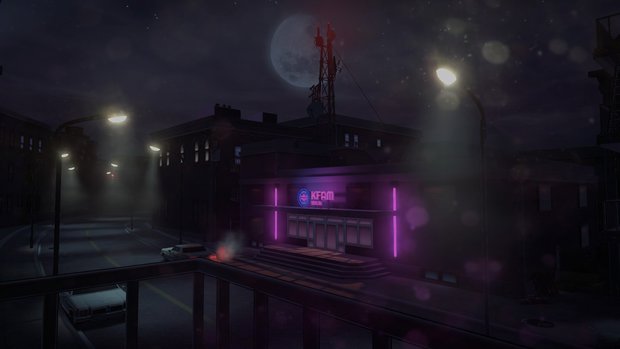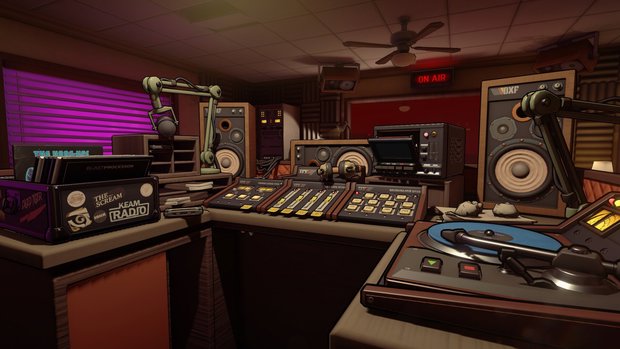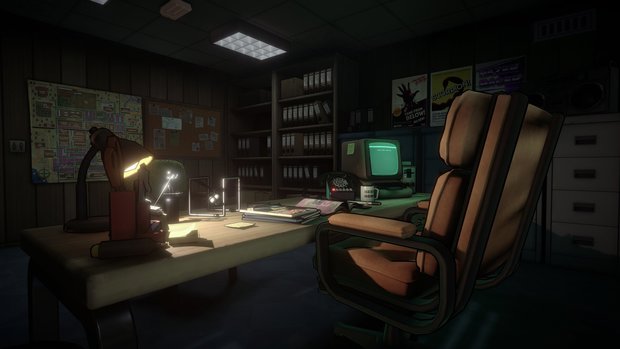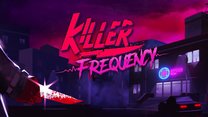Killer Frequency review

- 1 Comment
Choice-driven thriller slickly executes a remote survival horror experience anyone can enjoy
The slasher genre is still with us. But how to keep it innovative? Coupled with the 80s nostalgia revival of the past few years, Team17 Digital gives us a fresh perspective on a familiar theme with Killer Frequency. Technically speaking it’s a first-person survival horror game, but instead of playing as the potential victim, you’re a late-night local radio DJ moonlighting as the emergency dispatcher trying to assist the people calling for help. It’s a narrative game, heavy with dialogue but with very limited exploration, where you decide the fate of the town’s inhabitants. Do you step into the hero’s shoes and try to save all of them, or will you let your sadistic side rise and actually team up with the killer to herd them all into his arms? The choice is yours. Either path promises about five hours of compelling choice-based storytelling, so pick a record, pump up the volume and start to improvise, ’cause it’s time to go on the air!
Killer Frequency starts with a small tutorial introducing an unknown character to the basic mechanics of moving around and interacting with objects at the radio station of Gallows Creek, USA. In a first-person point of view, you find yourself in a dirty and cluttered alleyway. Here and there on-screen instructions will pop up, hovering in mid-air over a section of the environment you can manipulate. You freely move with the directional buttons or WASD (my game controller didn’t work for some reason) and you look around with the mouse. (You can experience the game in VR mode on Quest devices as well, but I played on a standard monitor.) Smaller items you find can be picked up and carried with you – there’s no elaborate inventory, you just hold items in front of you, one at a time – then dropped or thrown away as you make your way to a door at the end of the alley.
From that point on you assume the role of Forrest Nash, once a successful radio host in Chicago with millions of listeners, but for some reason now leading the life of a has-been for an audience of 35. Funnily enough, your producer Peggy behind the soundproof window still needs to teach you the ropes: how to put on a record, adjust the volume sliders, work the tape deck, take phone calls, play sound effects – all under the guise of routine checkups before starting the show. Necessary information for the first-time player, of course, but you can skip these instructions if you want.

The actual job of being a DJ consists of fairly mundane and cumbersome tasks, like always having to start and stop playing records between phone calls. I didn’t recognize any of the songs featured in the game; I think it’s all original music and if so, the developers did a bang-up job bringing us back to the sound of the 80s, though it would’ve been nice to hear some familiar songs. I had fun trying to play fitting sound effects during conversations, like a booing audience, a drum roll, or my favorite: a choir singing hallelujah! If you really find yourself bored, you can throw crumpled up paper balls into one of those little office basketball nets; I’m sure there’s a Steam achievement hiding there somewhere. In short, there are plenty of little details in this very realistic-looking world.
Of course, this is no ordinary night, and it won’t be long before your show turns into something much different – and deadlier – than ever before. A killer called The Whistling Man is ruthlessly terrorizing the town, and has already disposed of all law enforcement personnel, but not before the last cop alive managed to hook you up as the new emergency responder to field calls from citizens fearing for their lives. You are their last line of defense, and they’ve counting on you for their survival.
Killer Frequency is as vocally authentic as it is visually. Voices are everything in a radio show, and Forrest Nash really does sound like he could be an on-air celebrity. Producer Peggy is particularly perky, and the variety of callers all represent believable, instantly recognizable slasher movie stereotypes like the jock, the nerd, the frat guy, the politician, the hillbilly, and the owner of the pizza place always trying to find new ways to get free ads.
Each actor delivers their lines with the right touch of fearful emotion when things get serious, but before that are fittingly light-hearted when the focus lies more on whimsical radio banter. That’s important, because you never actually get to SEE these people, so these exchanges need to make them relatable as people worth saving.

Adding to the realism, walk away from your desk and the voice volume of callers or your producer drops, so you might want to enable the subtitles. You can also turn on text panels if you’re having trouble reading in-game objects you find strewn about the place like post-it notes, cards, letters, and other documentations. I didn’t really use this myself, since I found everything quite legible, and it’s also very obvious which documents you encounter can actually be read and which only hold gibberish in a kind of indecipherable doctor’s handwriting.
When talking to callers, dialogue options always pop up on a fixed screen next to your microphone. You can wander around the studio but you’ll always have to return to that general spot if you want to reply to people. When you do, you can shape Forrest’s personality by the nature of his replies. You can make him understanding and polite, or you can turn him into an insulting jerk. Often there’s a very short time limit to respond, so you’ll have to keep on your toes to give your callers the right piece of advice under stress.
Of course, keeping silent can be a conscious decision as well. With Peggy, nothing major will happen when you let the timer run out, as she’ll continue to talk by herself. Doing that with a caller, though, could very well sign their death certificate. Except perhaps during those times when keeping mum is actually the key to keeping them alive. Strangely, it’s possible to keep callers waiting when there’s no time limit. Dialogue options without a time limit keep hanging around while you go exploring the studio until you decide to come back and resume with a reply.
Giving that right piece of advice is what the gameplay all comes down to. You’ll receive calls from townspeople in danger, and you need to provide them with information to get them to freedom. This goes from figuring out an escape route from a corn maze, to walking them through the steps of giving someone first aid. When necessary, you can leave the studio to search the rest of the building for the information you need. If there’s still something left to do inside the studio, the game won’t let you leave yet, with a message popping up stating there’s more to do first. When it’s time to explore, however, Peggy will tell you where to go, and it’ll be obvious you can leave the room.

Then it’s time for some detective work, because often you’ll need to follow a series of clues to find what you need. Searching for the necessary information doesn’t take long at first, but as the game progresses you’ll be spending more and more time outside of your studio, which is good because staying any longer in that limited environment would become boring and perhaps even claustrophobic. Roaming the deserted building brings its own tension; you’re constantly on edge about bumping into the killer, who appears to be able to move around like a ghost based on the callers’ statements. You can accidentally topple over stuff, causing it to crash to the ground, and several times I scared myself that way.
Most of the puzzles are about deduction. There’s a very logical solution to everything, and there’s a variety of ways you can help the ten or so murder targets who call you for help. For instance, at one point a woman needs to drive away from the killer but she’s lost her keys. Luckily the radio station also broadcasts a car show, so you’ll have to find their offices and look for a way to help her, which in turn may yield another clue that sends you somewhere else.
Conveniently, you can take as long as you want searching around. The person you’re trying to help will only call back once you’ve returned to your studio. I have no idea what the killer has been doing in the meantime; he seems to be either a very patient maniac or a pretty incompetent one. Or maybe he’s enjoying the game of cat and mouse he’s playing with you and is willing to wait to let you keep up.
To be honest, I was a bit apprehensive before actually playing Killer Frequency. I thought I would have had to redo lots of time-limited sections to save everyone, and I was afraid my heart would be racing throughout the game, but I didn’t really encounter many problems. It’s like as soon as the going gets tough, there’s no time limit at all, as if the developers were very much aware that a game like this should be fun, not aggravating. The challenges here are of the mind, and not ones of dexterity or fast reflexes.
If you’ve lost track of your current objective, a quick look into the menu provides you with exactly what you’re supposed to be doing at any given time. You’ll also notice a couple of collectibles, namely hidden keys (which you’ll acquire automatically during the course of the story), music records (for which you’ll definitely have to keep your eyes peeled), plus how many baskets you scored from your desk. The menu will also show how long it’s been since the game autosaved. It does so pretty often, but if you want you can still save manually, which can be handy if you want to try out different ways to handle a particular caller. Besides the autosave there are only three manual save slots available, but at least that’s better than nothing!
There’s a history to this killer which you’ll slowly uncover, and as the story develops you’ll come to love Gallows Creek and its quirky inhabitants. While the finale is a bit too much exposition, it does wrap things up quite nicely. My first playthrough took me a little over five hours and I managed to save everyone, yay! Afterwards I played again, but this time I let my dark side surface and I succeeded in getting everybody killed, mwuhaha! I’m almost ashamed to admit how much fun I had with that. Playing the good guy means puzzling your way through a variety of logical deductions to reach that awesome feeling of triumph every time you save someone; playing the bad guy actually has you laughing out loud with how the characters meet their demise, followed by some funny comments from the DJ if you so choose. If you do indulge your inner wickedness, however, you’ll miss some story elements since the people who can provide them will be dead, and the finale plays out much faster, so if you’re planning on a replay, I really recommend my order of playthroughs.
Final Verdict
There’s limited freedom to roam in Killer Frequency, and not much to being a DJ, but the variety of gameplay kept me entertained and being an interim 911 operator sure is exciting, whether I played the hero or villain. Lives are very much at stake, but the great part is, you don’t need any action game experience to succeed. This is a more passive survival horror experience perfect for those who don’t like blood and gore, where all it takes is your brain and the ability to see solutions in all the clues provided. Every caller brings new elements that pose a challenge, but without being overly difficult. And even though you don’t see – or perhaps because you can’t see – what’s happening to the people in your care, there’s still a great buildup of tension. And it’s equally fun no matter which mindset you choose: being the grand savior is very rewarding and satisfying, but intentionally screwing up is just too tempting not to give it a go. I highly recommend it even to those who can’t bear to watch a horror movie – it’s perfect for a home-alone, late-night gaming session with the lights off and a bowl of popcorn at hand.
Hot take
Killer Frequency is a compelling choice-driven, non-action-oriented survival horror game that demands you keep your wits about you. If you really want to become the hero, you’ll enjoy every tense minute of it. Fail or consciously turn to the dark side, however, and you’re awarded with funny deaths and dark humor. Either way, it’s well worth giving it a spin.
Pros
- A variety of creative deductive puzzling
- Realistic look, sound and feel of being back in the 80s
- Focus is on making weighty decisions and having fun, not on aggravating timed sections
Cons
- Inconsistent rules for the passage of time and the urgency of player actions
- Some recognizable songs would’ve been nice
Johnny played Killer Frequency on PC using a review code provided by the game's publisher.










1 Comment
Want to join the discussion? Leave a comment as guest, sign in or register in our forums.
I would've written this one off almost immediately due to not much liking horror-themed games, but after reading the review, I might give it a second look. I like the idea of the limited perspective of most things happening off-screen.
Reply
Leave a comment